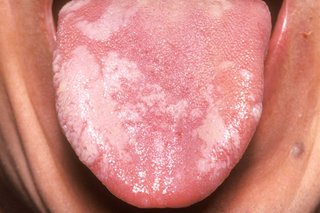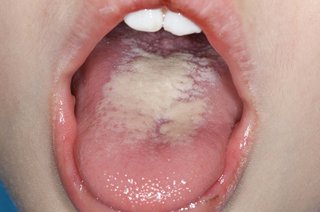A sore or white tongue is not usually serious and is often easily treated.
Things you can do if you have a sore or white tongue
Do
use a soft toothbrush to brush your teeth
brush your tongue or use a scraper to help improve a white tongue
use a straw to drink cool drinks
take paracetamol or ibuprofen
Don’t
do not use a toothpaste that contains sodium lauryl sulphate
do not eat spicy, acidic or hot food and drink that may irritate your tongue
do not smoke
do not drink alcohol
A pharmacist can help with a sore or white tongue You can ask a pharmacist:
what's causing your sore or white tongue if you can buy anything to help with any pain or irritation if you should see a dentist or GP
Non-urgent advice: See a GP or dentist if:
you have tongue pain or itchiness that does not go away or gets worse you have white patches on your tongue
Common causes of a sore or white tongue
Biting or burning your tongue with hot food or drink can cause pain and swelling. This should only last a few days.
A white tongue can be a sign of a health condition, such as anaemia, scarlet fever, lichen planus, leukoplakia, geographic tongue, mouth ulcers or oral thrush.
But do not self-diagnose. See a GP if you're worried.
Lichen planus
Lichen planus can cause white patches on the tongue and inside the cheek.
Credit:
DR P. MARAZZI/SCIENCE PHOTO LIBRARY https://www.sciencephoto.com/media/641882/view
Read about lichen planus .
Leukoplakia
Leukoplakia can cause white, raised patches on the tongue, inside of the cheeks, or on the gums, that do not come off when you rub them.
Credit:
Alamy Stock Photo https://www.alamy.com/stock-photo-hairy-leukoplakia-31088074.html?pv=1&stamp=2&imageid=50B53D74-85FC-4C29-8279-1752D2D567FB&p=17774&n=0&orientation=0&pn=1&searchtype=0&IsFromSearch=1&srch=foo%3dbar%26st%3d0%26pn%3d1%26ps%3d100%26sortby%3d2%26resultview%3dsortbyPopular%26npgs%3d0%26qt%3dBPG54A%26qt_raw%3dBPG54A%26lic%3d3%26mr%3d0%26pr%3d0%26ot%3d0%26creative%3d%26ag%3d0%26hc%3d0%26pc%3d%26blackwhite%3d%26cutout%3d%26tbar%3d1%26et%3d0x000000000000000000000%26vp%3d0%26loc%3d0%26imgt%3d0%26dtfr%3d%26dtto%3d%26size%3d0xFF%26archive%3d1%26groupid%3d%26pseudoid%3d144292%26a%3d%26cdid%3d%26cdsrt%3d%26name%3d%26qn%3d%26apalib%3d%26apalic%3d%26lightbox%3d%26gname%3d%26gtype%3d%26xstx%3d0%26simid%3d%26saveQry%3d%26editorial%3d1%26nu%3d%26t%3d%26edoptin%3d%26customgeoip%3d%26cap%3d1%26cbstore%3d1%26vd%3d0%26lb%3d%26fi%3d2%26edrf%3d0%26ispremium%3d1%26flip%3d0%26pl%3d
Read about leukoplakia .
Geographic tongue
Blotchy, red patches on the tongue that have a white or light-coloured border may be geographic tongue.
Credit:
DR P. MARAZZI/SCIENCE PHOTO LIBRARY https://www.sciencephoto.com/media/832122/view
Find out more about geographic tongue on the Oral Health Foundation website
Mouth ulcer
Mouth ulcers are round, painful and swollen sores that look like blisters and can appear on the tongue, inside of the cheeks, or the lips.
Credit:
DR P. MARAZZI/SCIENCE PHOTO LIBRARY https://www.sciencephoto.com/media/115960/view
Read about mouth ulcers .
Oral thrush (mouth thrush)
An itchy, red mouth with white patches on the tongue could be oral thrush. It's more common in babies and older people with dentures.
Credit:
DR P. MARAZZI/SCIENCE PHOTO LIBRARY https://www.sciencephoto.com/media/81735/view
Read about oral thrush (mouth thrush) .
Page last reviewed: 16 May 2023




